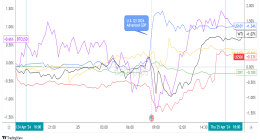Nearly five years after all-electric racing series Formula E made a thrilling debut, the book is about to close on its fifth season. Crucially, this was also the first season with Formula E’s game-changing second-generation electric racecar, which is faster, lasts longer, and could help propel the series into more legitimate motorsport territory.
In April, I drove one on a racetrack.
I actually drove the series’s first-generation car back in 2017, but I’ve had the urge to try the new one ever since it was announced in 2018. Not only does it look totally bonkers, but it’s a significant upgrade in just about every way. The old car had a max power output of 200kW or about 268 horsepower. The second-generation car (or “Gen2 car,” as everyone in the sport calls it) tops out at 250kW or 335 horsepower. The old car’s top speed was 150 miles per hour; the new car peaks at 174 mph and can go from 0 to 60 mph in under 3 seconds. Considering the series hadn’t run a single race on this day five years ago, that’s pretty good.
One thing that shocked me when I got behind the wheel of Formula E’s new all-electric racecar in April is how simple it is to drive. There are no gears like there were in the original car. Like its predecessor, it uses treaded tires instead of racing slicks so I didn’t have to worry about warming them up to exactly the right temperature like I would in, say, a Formula One car. Even the halo — the flip-flop-looking safety device that now sits over the cockpit of the car — mostly disappeared in my vision once I was seated.
:no_upscale()/cdn.vox-cdn.com/uploads/chorus_asset/file/16310814/formula_e_gen_2__3.jpg)
The most surprising thing, though, was that Formula E’s Gen2 car felt easier to drive than the first-generation one — and not just because I was driving it in a power-limited mode. The throttle is smoother. The brakes are far more forgiving and progressive than the ones on the old car (which were very easy to lock up), thanks to a new brake-by-wire design. The steering is more fluid and precise. Overall, the car felt like it rattled less — something that’s very easy to notice given the lack of engine noise.
I’m not saying the Gen2 car is actually easy to drive. It’s not: 335 horsepower might not sound like a lot, but step on the throttle too early when exiting a corner or with too much oomph, and the electric motor and its instant torque will send the back wheels (and probably the car) spinning before you know it. Time the braking poorly after eclipsing 100 miles per hour on a straightaway, and it doesn’t really matter how forgiving the brake pedal is. Circuit de Calafat, the track I drove it on, is tight and technical, and more than one other person there that day spun or sent the car into the gravel.
What’s more, after just a few laps in the Gen2 car, which weighs 900 kilograms (1,984 pounds) and doesn’t have power steering, my arms were fully cooked. Not to mention I didn’t have to deal with all the other stuff that comes with actually competing in this car, like doing 12-hour days in a simulator to prepare for a race or managing the battery level while fighting for position inches away from the imposing walls of a street circuit.
Still, I got comfortable enough with the Gen2 car that it made the first-generation one feel like a prototype. In the old car, I felt like I was somewhat close to its limits. In the new one, I sensed how much more it could handle.
:no_upscale()/cdn.vox-cdn.com/uploads/chorus_asset/file/8900711/sokane_1865_formula_e_brooklyn_racing_06545.jpg)
I also wasn’t purely relying on my memory, here; Mahindra Racing, the team that let me drive the new car, had me take a few laps in one of their first-generation cars in Spain as well. I was working with a fresh comparison, and the differences were glaring. Even after four seasons of development, the original car felt like the beta version of Formula E, the one that helped the series work out all the kinks.
That is largely true! The first-generation car was known to occasionally overheat. It used a battery that could only last around 25 minutes, which required drivers to pit halfway through each race to switch cars. It cost about half as much (some €400,000, or about $445,000) as the Gen2 car, which has a price tag of a little over €800,000 (or about $900,000).
More than anything, the Gen2’s composure signaled to me that it’s a car that can be pushed to higher limits in the right hands. The specs might be a little more impressive on paper, but the refinements I noticed during my few laps in the cockpit ultimately define a car that can handle more aggressive driving. Drivers aren’t quite so much at the mercy of this new car as they were in the old one where, for example, they had to manually change the balance between the traditional brakes and the electric motor’s regenerative braking each and every lap using a dial on the steering wheel.
:no_upscale()/cdn.vox-cdn.com/uploads/chorus_asset/file/16310847/Spacesuit_Media_Lou_Johnson_FIA_Formula_E_Mahindra_Barcelona_April_2019_5527.jpg)
The genius of Formula E during its first few seasons is that the series organizers didn’t fight the perceived shortcomings of the first-generation car, they embraced them. They used these limitations to the series’s advantage. The cars don’t make much noise? Great. Host cities will love that. The batteries don’t last long? Wonderful, the younger audience we’re targeting has a short attention span anyway. The speeds aren’t blinding? Fantastic. Smaller street circuits will make top speed irrelevant, create more braking opportunities to send energy back into the batteries, and they’ll also (again) be more palatable for host cities since they take up less space.
Now, with a more solid, capable, and frankly exciting car at the center of the series — not to mention the buy-in of some of the world’s biggest automakers like Audi, BMW, Nissan, Mercedes-Benz, and Porsche — Formula E’s organizers are building on that foundation. They have fewer limitations to work with, and they find themselves in a rare position in the world of motorsports where they can now try even bolder ideas, ones that could set the series apart and, if they get enough of them right, help define what the future of racing looks like. No pressure.
This article is from The Verge







